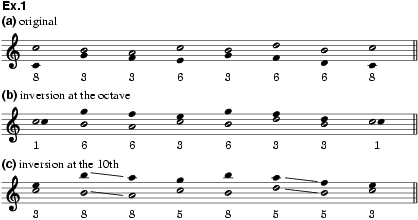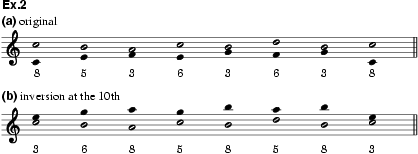
The contrapuntal design of two or more parts in a polyphonic texture so that any of these parts may serve as the highest part or as the bass. Invertible counterpoint involving two (three, four) parts is called double (triple, quadruple) counterpoint.
The underlying principle of invertible counterpoint is the Inversion of intervals with respect to some fixed interval. For instance, ex.1a shows a cantus firmus (given in semibreves) with a note-against-note solution beneath, and in ex.1b the same two parts are inverted ‘at the octave’. The lower part is moved up an octave, and the intervals between the two parts become the complements of those in the original setting: unisons become octaves, 3rds become 6ths and 6ths become 3rds.
The inversion of a consonant interval is not always consonant. For instance the 5th, inverted at the octave, becomes a 4th (which is treated as a dissonance in note-against-note counterpoint); the 6th, inverted at the 12th, becomes a 7th. This means that the choice of intervals between the parts of a passage in invertible counterpoint is restricted, dependent on the interval of inversion.
Moreover, not only must the concept of consonance and dissonance be respected, but the rules of Part-writing must also be observed. For example: at the interval of a 10th, consecutive 3rds and 6ths invert to consecutive octaves and fifths, and must therefore be avoided. Ex.1c illustrates the unsuitability of the ‘solution’ in ex.1a for inversion at the 10th; an alternative solution to the same cantus firmus – one which can be inverted at this interval – is shown in Ex.2.


An exhaustive discussion of the applications of invertible counterpoint is found in S.I. Taneyev’s Podvizhnoy kontrapunkt strogogo pis'ma (Leipzig and Moscow, 1909; Eng. trans., 1962, as Convertible Counterpoint in the Strict Style). The standard English textbook has been Ebenezer Prout’s Double Counterpoint and Canon (London, 1891).
As a musical discipline, invertible counterpoint has remained within the domain of strict counterpoint since it was introduced by Vicentino in L’antica musica ridotta alla moderna prattica (1555). As a compositional technique, though, it was used infrequently until the Baroque era, when the bass was established as a fully developed line with a recognizable contour and a melodic identity of its own. In fugue the relationship of counter-subject to subject makes their invertibility almost an a priori condition; invertible counterpoint flourished in fugues and other compositions in a strict polyphonic style. In such works as Bach’s Three-Part Invention in F minor, invertibility may be said to be used as a structural principle; and in works like Die Kunst der Fuge and the Canonic Variations on Vom Himmel hoch he lifted the technique to a level far above that of an ‘academic’ exercise.
For bibliography see Counterpoint.
WILLIAM DRABKIN